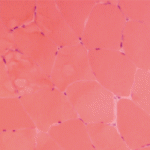Overlap Myositis in RA & SLE
In one of the first studies of OM in RA, conducted in 1984, 31 patients with active RA with peripheral joint inflammation were noted to have rheumatoid myositis, in which muscle biopsies showed interstitial, perivascular inflammation and myofiber necrosis.18 Since then, there has been a dearth of studies but in the clinical context, Dr. Paik said that “when we see patients with OM with RA, we’re really seeing patients with the antisynthetase syndrome.”
In a 2018 large cohort study of anti-Jo-1 patients, 64% of patients presented with symmetrical arthritis at disease onset. Anti-citrullinated protein antibody (ACPA) positive patients with the antisynthetase syndrome also tend to have higher swollen joint counts and more radiographic damage.19
Unfortunately, little data exist regarding myositis overlapping with SLE, said Dr. Paik. One NIH study in 1981 demonstrated that of 228 SLE patients, only 8% had muscle involvement, and aldolase may be a better marker than CK to assess for muscle involvement.20 A 1994 study evaluated muscle histopathology in 55 SLE patients and compared them to 26 controls and found these patients had a lymphocytic vasculitis as well as type-2 fiber atrophy, although this likely due to the fact that they were on corticosteroids.21
A flow chart helps users subclassify patients with a confirmed IIM: They first consider the patient’s age of disease onset; patients under 18 are subclassified as having juvenile dermatomyositis (JDM) if they have a skin rash & juvenile myositis if they do not have a rash. Patients over 18 with a skin rash & muscle weakness are classified as having dermatomyositis (DM), & those without muscle weakness as having amyopathic DM.
In terms of autoantibodies in OM, three autoantibodies have commercially available tests. They are anti-Ku antibodies, anti-PM-Scl and anti-RNP, said Dr. Paik, who co-authored a new study of 2,175 patients in the Johns Hopkins Myositis Cohort. This study was conducted to determine the clinical phenotype of OM patients with PM-Scl autoantibodies. They identified 949 patients who had had autoantibody testing, and of these, 41 had anti-PM-Scl compared to disease controls.22
“Anti-PM-Scl-positive patients had extensive extramuscular symptoms, which is not surprising,” she said. For example, these patients had more pronounced Raynaud’s phenomenon, mechanic’s hands and calcinosis than patients with other types of myositis in the study, including those with the antisynthetase syndrome, she said. They had less prevalent ILD than those with the antisynthetase syndrome, and also had more weakness in their arm abductors than their hip flexors. When muscle histopathology was evaluated in these 41 anti-PM-Scl-positive patients, intense perivascular inflammation was a common theme on muscle biopsy.
Anti-U3-RNP positivity is also higher in patients with overlap myositis. These patients tend to be African American, and have diffuse scleroderma, early-onset pulmonary hypertension, skeletal myopathy and severe GI disease, said Dr. Paik.23
Lastly, anti-Ku is seen in OM with SSc more often than in SLE, and some studies report that myositis in these patients tends to be mild with good response to treatment. These patients often have myofiber necrosis and inflammatory infiltrates, and a subset of anti-Ku-positive SSc patients with OM have a higher risk of severe ILD, she said.24

